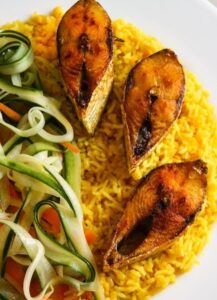With the monsoon still in full flow, and with the rain god seeming to be in a generous mood even in normally bone-dry Delhi, Samita Haldar, who last talked about the rural cuisine of West Bengal, dwelt on how the everyday menus of homemakers in her home state go beyond ‘khichuri’ (khichri) and ‘ilish’ (hilsa fish) even as it pours outside.
And like anything else to do with Bangla Ranna (Bengali Cuisine), the sheer variety and diversity of the ingredients and the food that are laid out on the table are mind-boggling. The world, for instance, knows about anchovies (which the Bengalis call ‘mourola’), but, as Samita explained on ‘Food Talk with Sourish Bhattacharyya’, an array of other fresh-water small fish don’t escape the attention of the Bengali cook on rainy days – and the fish come with evocative names such as ‘pooti’, ‘bashpata’, ‘kachki’, ‘gooley’ and ‘pine maachh’ (the Bengali word for fish, incidentally, is ‘maachh’).
‘Khichuri’, however, enjoys a special status in the monsoon months. Few other people treat khichri with as much respect as the Bengalis, who, unlike their counterparts in the North Indian hinterland, do not view the dish as something that only the sick and the indisposed should be condemned to have.
Samita pointed out that the Bengalis commonly have a runny ‘kichuri’ prepared with either ‘masoor’ or ‘moong dal’ (the latter could be roasted), and it is very different from the ‘bhoger khichuri’, which is offered to the gods and comes with potatoes as well as other vegetables, or the ‘bhooni khichuri’, which has peanuts and cashews, and a consistency very close to that of a pulao.

Typically, though, an everyday ‘khichuri’ would have a mix of moong and masoor dal, the short-grained and aromatic gobindobhog rice, potato and seasonal vegetables. The ‘mamlet’, which is how the Bengalis like to call the omelette, is the most favoured accompaniment. “Mamlet is a must with khichuri,” Samita said. “And what is the difference between ‘mamlet’ and omelette? Well, the ‘mamlet’ has to be fried in mustard oil and has chopped onions and green chillies in it.” Desi ghee is the other must with ‘khichuri’. “The ghee in Bengal has a unique flavor and we spread it liberally on ‘khichuri’,” Samita said.
The discussion then turned to the richness of West Bengal’s home kitchen. Just like the small fish, even the fresh-water prawns come in multiple shapes and sizes, and each has a unique name – from the better-known ‘golda’ and ‘bagda chingri’ (jumbo and tiger prawns) to the less popular ‘kedo’ and ‘phool chingri’. “We use different kinds of prawns for different preparations,” Samita explained as she shared a teaser of the dish she would go on to cook for our cameras – small prawns bathed in a tangy mustard and poppy seed (‘posto’) sauce, and steam-cooked in a tiffin box.
Likewise, the small fish are cooked differently with different vegetables. The humble ‘mourola’, for instance, can lend itself to a dry ‘chorchori’, watery ‘jhol’ or tangy ‘jhal’, and can be steam-cooked as well. That is the beauty of Bengali cooking. Within one genre – cooking fish or vegetables, for instance – you can produce amazing variety, each tasting different and arriving on your plate in a different consistency: ‘chorchori’ (dry), ‘ghonto’ (mishmash), ‘jhal’ (tangy), ‘jhol’ (thin, flavourful gravy), ‘kosha’ (the equivalent of ‘bhuna’) and ‘rosha’ (rich curry cooked with onions and tomatoes, and flavoured with ghee and garam masala). As we can see, each name signifies a unique cooking style.
A couple of days before the interview, Samita said she had made a ‘chhyachra’ (mishmash), a variant of the vegetarian ‘pui saag’ (Malabar spinach) chorchori, with a hilsa fish head and a medley of 11 vegetables, including ‘arbi’ (taro) and ‘thor’ (stem of the banana plant).

Even the palate cleansers that come at the end of a meal, before the dessert course, are known by different names, from the sweet and sour ‘ambol’ (which, ironically, also means ‘acidity’ in Bangla!) to the more-sour-than-sweet ‘tok’, to the wedding party must-have: ‘plastic chutney’ made with pineapple or raw papaya slivers. And although raw mango is the favoured main ingredient of these palate cleansers, the humble ‘amra’ (hawk plum) is a hot favourite in the monsoon months. Unripe ‘chalta’ (elephant apple) is another star of the Bengali monsoon and its ‘tok’ does revive your taste buds after they’ve worked hard on a feast.
Talking about what she’s doing to make the monsoon special, Samita mentions cooking with ‘pui saag’, ‘kochur loti’ (Colocasia leaves) and ‘thor’, and her preferred rice variety this season is the short-grained, aromatic ‘chinigura’, which is very different from ‘gobindobhog’. This rice is a must when you are making the mutton biryani of Dhaka. Another rice variety that has grabbed her attention is the fragrant, black-husked ‘kalanamak’ from Siddharth Nagar in Uttar Pradesh, the birthplace of Gautama Buddha.

Home chefs such as Samita are reviving ingredients that are disappearing from urban tables – they are now called ‘lost ingredients’, but they can never be ‘lost’ as long as Samita and others of her ilk have their way. The traditional way of eating was what we fancifully describe today as ‘sustainable’ or ‘plant forward’.
No part of a vegetable or fish was ever wasted – from the head to the tail of the fish, and from the stem of the plant (banana), flowers (banana again and moringa) and leaves (neem) to the fruit (raw and ripe banana, and moringa). It ties in vey well with the We The Chefs philosophy of promoting sustainable lifestyles based on additive-free ingredients, local sourced seasonal vegetables and fish, and zero-waste cooking processes.
KEYWORDS: Bengali Cuisine; Bangla Ranna; Sustainable Lifestyle; Zero-Waste Cooking; Khichri; Ilish; Gobindobhog Rice; Kala Namak Rice; Chiniguro rice; Mourola; Pui Saag; Chorchori; Ambol

